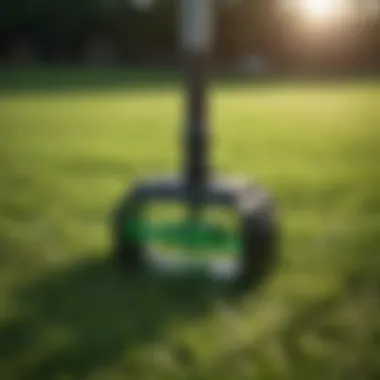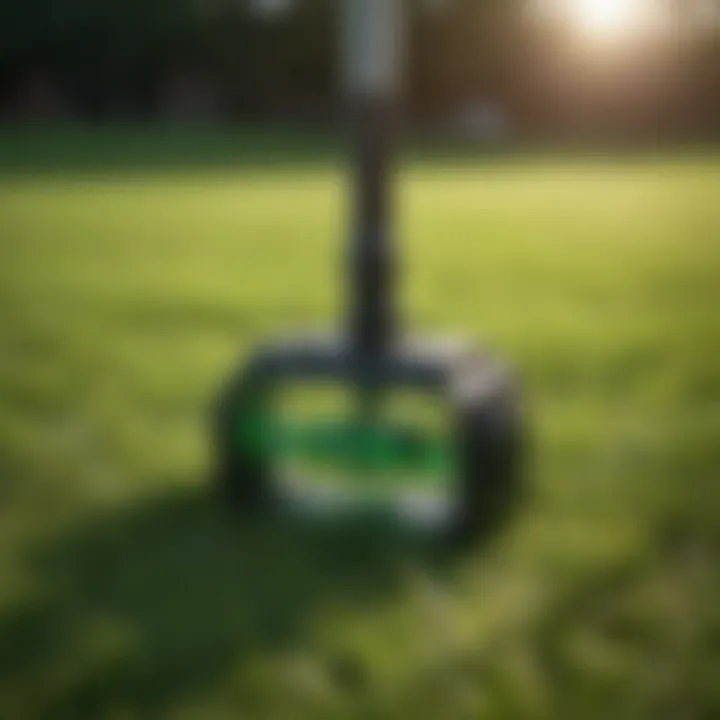The Essential Guide to Lawn Aeration and Seeding


Intro
Creating a lush, vibrant lawn doesn't just happen overnight. It takes time, effort, and a keen understanding of the natural processes that foster healthy grass growth. Among these processes, aerating and seeding play pivotal roles, acting as cornerstones in lawn care. Without these, a lawn can become compacted, nutrient-depleted, and susceptible to pests and diseases.
In this guide, we dive into the significance of aerating and seeding, examining how they can transform even the most lackluster patches into lush greenery. This exploration isn't just for the seasoned gardener; homeowners just starting their lawn journey will also find practical insights. From the tools you need to the timing for execution, we cover the methodology in detail, offering tips that can save both time and resources.
Design Inspiration
Trending Styles
As we consider how to maintain and enhance the beauty of our lawns, various styles are emerging that catch the eye of gardening enthusiasts. A lawn is often seen not just as a green space but as an extension of the home, showcasing personal style and preference. Incorporating patterns into your lawn through methods like striping, checkerboarding, or mixing grass types can elevate its aesthetic.
Imagine your lawn divided into sections with varying textures or shades of green. This not only caters to the eye but also promotes a healthy ecosystem. Grass varieties like Kentucky Bluegrass contrast beautifully against Fine Fescue—each serving different ecological purposes.
Color Palettes
Though you may not think of colors in relation to grass, they do have their own palette, influenced by the variety chosen. Consider blending vibrant greens with subtle blues of certain grass types or the rich browns of soil peeking through.
A well-maintained lawn can also make a stark contrast against flower beds or shrubbery. Selecting complementary colors between your grass and nearby plants enhances the overall visual appeal. This does not only beautify the garden but also nurtures a sense of calm and balance within the space.
Practical Tips
Maintenance & Care
Aerating and seeding are not just one-time actions; they need follow-up maintenance to ensure success. It's essential to monitor soil moisture, especially after seeding. New seeds require consistent moisture to germinate. However, be careful not to overwater, as soggy soil can lead to other issues, such as root rot.
"The two most important actions for maintaining a healthy lawn are aeration and proper seeding."
To sustain your efforts:
- Mow Regularly: Keep the grass to a recommended height to encourage healthy root development.
- Fertilize: Post-seeding fertilization will provide nutrients that were lost during the aeration process.
- Weed Management: Addressing weeds early can prevent them from choking your newly sprouted grass.
Budgeting & Planning
Financial planning for lawn care might seem daunting, but it can be broken down. Aerating tools, for instance, range in price, and it’s beneficial to compare rental versus purchase costs. Look into local gardening clubs or community areas where you might share tools.
Additionally, when choosing seed types, consider their long-term survival:
- Perennial Ryegrass: Quick to germinate, perfect for patches.
- Bermudagrass: Great for sunny spots, provides strong growth during summer.
- Tall Fescue: Ideal for transitional zones, drought-resistant.
Assess your climate and soil type to ensure you choose the right seeds. The upfront cost will pay off in the long run with a lawn that serves as a source of pride for any homeowner.
Understanding Lawn Aeration
Lawn aeration is a cornerstone practice in maintaining a healthy and lush landscape. While some might not think twice about their grass, understanding the nuances of aeration can lead to significant improvements. This process doesn't just punch holes into the dirt; it's a means of facilitating better growth, nutrient distribution, and moisture retention. For many homeowners, knowing when and how to aerate can transform an average lawn into a vibrant, green sanctuary.
Definition and Purpose
At its core, lawn aeration refers to the practice of perforating the soil with holes to allow air, water, and nutrients to penetrate down to the grassroots. The essence of aeration lies in the fact that soil can become compacted over time, leading to less oxygen availability for the roots. This lack of oxygen can stymie growth and reduce the overall health of the lawn. Therefore, conducting aeration addresses this soil compaction by creating pathways for essential factors needed for growth.
Benefits of Aeration
Increased root growth
One of the distinct benefits of aeration is increased root growth. When soil is aerated, the oxygen supply available to the roots rises, and they can expand more freely. This downwards push of roots allows for a stronger, healthier grass that can withstand typical wear and tear. Without proper aeration, roots can become stunted and concentrated too close to the surface, making the lawn more susceptible to drought or disease.
Improved nutrient absorption
Another significant advantage lies in improved nutrient absorption. Aeration opens up the soil and provides a better opportunity for fertilizers and organic matter to seep into the earth. This means that rather than just staying on the surface or being washed away during rain, nutrients have a better chance of reaching the root zone. Healthy nutrient uptake directly translates into vigorous growth and rich green color that many homeowners desire.
Enhanced water retention
When we discuss enhanced water retention, it's crucial to understand how aeration alters the soil's capacity to hold moisture. Aerated soil tends to have a better structure, allowing for water to infiltrate and be held more effectively. Instead of pooling on the surface and evaporating, moisture can penetrate deeper, thereby reducing waste and ensuring that grass roots have consistent access to water during dry spells.
Reduction of soil compaction
Soil compaction is a common enemy of lawn vitality, and aeration counters this by literally breaking up the dense layers that form over time. When soil gets compacted—often due to foot traffic or heavy machinery—it restricts root growth, water drainage, and nutrient flow. Aerating your lawn alleviates this pressure, leading to improved soil structure and a healthier ecosystem underground. Keeping your soil loose and breathable is essential for long-term sustainability.
When to Aerate


To reap the benefits of lawn aeration, timing is everything. Properly aerating during optimal conditions maximizes the effectiveness of the process.
Seasonal considerations
Aeration is often best in the spring and fall when grass is actively growing. The cooler temperatures and increased moisture create an ideal environment for recovery and new growth. Choosing these seasons means your lawn can bounce back more robustly without the harshness of summer heat or winter cold crippling the recovery process.
Assessing soil conditions
Evaluating soil conditions is another critical factor. If your lawn feels compacted or water tends to pool rather than absorb, it’s likely time to aerate. An effective approach involves grabbing a soil probe; if you can only penetrate a few inches, it’s time to get aerating. Soil tests can also help determine pH and nutrient levels, giving an even better understanding of your lawn’s specific needs.
Timing based on grass type
Different grass types thrive under varying conditions, thus timing should also be based on the type of grass you have. For instance, cool-season grasses are best aerated in early spring or early fall, while warm-season grasses flourish with aeration in late spring. Knowing your grass type helps tailor your lawn care approach, ensuring your efforts yield the best possible results.
In summary, aerating your lawn is about creating a healthier environment for your grass to grow strong and green. Proper understanding of the definition, benefits, and timing can make all the difference in achieving a lawn that not only looks good but thrives season after season.
Tools and Equipment for Aeration
When it comes to achieving a lush and vibrant lawn, the importance of the right tools and equipment for aeration cannot be overstated. Aeration is a practice that allows air, water, and nutrients to penetrate the soil more effectively, stimulating grass growth. The effectiveness of this crucial process can largely depend on the aeration tools employed. Choosing the right equipment not only enhances efficiency but also propels your lawn to perform at its best, ensuring you reap the rewards of your hard work.
Manual Aerators
Core aerators
Core aerators stand out for their ability to remove plugs of soil from the ground, thus creating small holes that promote air movement and moisture retention in the soil. A notable trait of core aerators is their efficiency in relieving soil compaction, which tends to happen over time due to foot traffic or heavy rainfall.
This type of aerator is a beneficial choice for homeowners looking to improve overall lawn health because the core removal leads to enhanced root growth across your turf. One unique feature is the ability to leave behind those soil plugs on the lawn after aeration, where they can decompose and nourish the grass, enhancing the organic material in the soil. However, the downside could be the physical effort required, as these tools often need manual operation, which can be exhausting if your yard is large.
Spike aerators
On the other hand, spike aerators work by punching holes directly into the soil without removing any plugs. They are typically lighter and can be easier to manage than core aerators, making them a popular choice among weekend lawn warriors.
What sets spike aerators apart is their simplicity and efficiency in situations where lawn compaction isn't too severe. For light-duty aeration, they can be effective. But there’s a caveat; without removing soil, spike aerators may not provide the same level of benefits as core aerators. So, while they’ll certainly help, they may not deeply address significant compaction issues that core aerators remedy perfectly.
Mechanical Aerators
Gas-powered aerators
The convenience and speed of gas-powered aerators are often unbeatable. These machines are ideal for those who have expansive lawns that require aeration, as they can cover ground in a fraction of the time compared to manual tools. A standout benefit of gas-powered aerators is their capability to handle tougher soil conditions and ensure deeper aeration due to their weight and power.
One unique aspect of gas-powered models is their ability to adjust depths for aeration, allowing greater versatility in lawn care. However, the noise and emissions are often seen as downsides of these machines, along with the maintenance and associated costs that can come with operating gas engines.
Electric aerators
Alternatively, electric aerators present a quieter, eco-friendly option for homeowners. These machines are powered by electricity, either through a corded connection or a rechargeable battery. In terms of benefits, electric aerators are easier to operate and maintain since they usually require less upkeep than their gas-powered counterparts.
A unique feature of electric aerators is the lightweight design, making them easier to maneuver, especially in smaller yards. But, they may not have the same power as gas options and their effectiveness can be limited in heavy, compacted soil. Homeowners must consider their specific lawn conditions when choosing between electric and gas-powered solutions.
Homeowner vs Professional Tools
When it comes to choosing between homeowner and professional-grade tools, the distinction often circles back to the intended use and frequency of aeration. Homeowner tools are typically designed for ease of use and are adequate for average residential lawns. They tend to be lighter and more maneuverable, often making them suitable for those trying to keep up their yard on a casual basis.
Professionals, by contrast, usually invest in high-grade equipment built for durability and extensive use. These tools can handle larger areas and more challenging soil conditions, making them a wise choice for those who either prioritize impeccable lawn care or operate landscaping businesses.
Ultimately, if you're just looking to aerate your backyard during spring and fall, homeowner tools might suffice. But if you're running a lawn care service or merely want the best for your yard, considering professional tools may lead to better results.
In the end, whether opting for manual or mechanical equipment, the right choice is pivotal in paving the way to a stunning lawn that thrives throughout the seasons.
The Aeration Process
The aeration process is a fundamental practice for anyone wishing to maintain a lush and healthy lawn. It serves as a bridge—connecting the soil with the essential resources that grass needs to thrive. When we talk about aeration, we’re discussing more than just poking holes in the soil; we’re facilitating an entire ecosystem of growth.
Aerating your lawn ultimately leads to healthier grass by improving the soil structure and allowing it to breathe. Jasmine, a homeowner with a half-acre yard, noticed a stark difference after aeration. The roots of her grass took hold more firmly, and she benefitted from stronger and greener blades in the subsequent growing season. A well-executed aeration process can help achieve such results, provided one prepares adequately and follows through with execution and maintenance.
Preparing Your Lawn for Aeration
Mowing considerations
One cannot simply jump into aeration without considering the state of the lawn. Mowing is an essential pre-aeration step, primarily for two reasons: to trim the grass to a manageable height and to ensure that the aerator effectively penetrates the soil.
It's typically suggested to mow your lawn to around 2.5 to 3 inches in height, which helps expose the soil properly. Some folks choose to mow lower, thinking it may help, but that's often a hit-or-miss approach that could damage the grass. Essentially, proper mowing height provides a balanced playing field for aeration, enhancing its overall effectiveness.


Furthermore, if the grass is too tall, the aerator might struggle in its task, leaving behind patches that could lead to uneven growth in the future.
Watering and soil moisture
Watering and soil moisture are crucial elements that directly impact the effectiveness of aeration. Ideally, your soil should be slightly moist but not soaking wet. When the soil is too dry, it becomes hard as rock, making it almost impossible for the aerator to penetrate. On the flip side, if the soil is overly saturated, the aeration holes may close up quickly, defeating the purpose.
You want to have that sweet spot of moisture, perhaps watering your lawn a day or two before you plan to aerate. This way, the aerator can work its magic efficiently, allowing nutrients and oxygen to reach the roots without too much struggle.
Executing the Aeration
Executing the aeration process is where the action begins, and it’s vital to do it right to reap maximum benefits.
Technique for coverage
When it comes to technique for coverage, overlapping is key. You wouldn't want to miss a single spot, since that could lead to uneven growth on your lawn later. Most experts suggest going over the same area in two directions, say north-south first, then east-west. This crisscross method ensures that no section is neglected.
It's a straightforward method that usually promotes better watering and fertilization penetration into the soil. Plus, if you own or rent a mechanical aerator, following proper technique minimizes the risk of missing patches—where thin grass could develop unwanted weeds.
Follow-up tasks
After the aeration is complete, you're not quite off the hook yet; follow-up tasks are just as important. At this stage, it’s advisable to apply seed or fertilizer to ensure a productive environment for new growth. The aeration holes act as little conduits, pulling nutrients deeper into the soil.
If you've applied grass seed, remember to keep the soil moist for the upcoming weeks. Daily checks are necessary—water lightly rather than flooding the area. This approach gives your lawn the best chance of flourishing beautifully in the spring or fall.
Properly executed, the aeration process can transform a tired lawn into a vibrant one, rejuvenating the very ground beneath it.
Achieving a lush green carpet underfoot doesn't just happen overnight or with a single effort; it takes a combination of the right techniques and ongoing care for your lawn to reach its true potential.
Seeding After Aeration
Seeding after you have aerated your lawn is a crucial step that can make all the difference in promoting healthy grass growth. When you aerate, you create channels in the soil which allow air, water, and nutrients to reach deeper into the ground. This lays the perfect groundwork for seeding, as it enhances the environment for new grasses to take root. Without this proper union of aeration and seeding, your efforts may fall flat, leading to patchy or sparse growth.
Understanding Grass Seed Types
Cool-season vs warm-season grasses
Cool-season grasses and warm-season grasses each serve distinct roles in lawn care, and understanding their differences is fundamental in creating a thriving lawn. Cool-season grasses, for instance, thrive during the cooler temperatures of spring and fall. Their robust characteristic is their ability to stay green when temperatures dip, making them a popular choice in northern climates. Conversely, warm-season grasses flourish during the hotter months, bringing life to lawns during summer. The unique feature of these grasses is their growth habits; while cool-season varieties often lay dormant in intense heat, warm-season types can die back during cold snaps. Thus, in choosing a grass type, the regional climate becomes a significant factor impacting growth and longevity.
Blends and mixes
Blends and mixes of grass seed involve the combination of different grass varieties. This method has become increasingly popular due to its advantages. One key characteristic of using blends is the diversity it brings to your lawn’s resilience. Weather changes can be unpredictable, and when one grass type falters, others in the mix may thrive, providing a buffer against total lawn failure. Additionally, certain blends are crafted to tackle specific lawn challenges, like shade or foot traffic. However, a disadvantage could be that if one of the varieties doesn’t blend well, it could outcompete others, leading to uneven patches.
Choosing the Right Seed for Your Lawn
Assessing local climate
Assessing the local climate is fundamental when selecting the appropriate seed for your lawn. This key feature lies in how different grass types respond to temperature, rainfall, and humidity. For instance, if you live in a region with harsh winters, opting for cool-season grasses can result in a lush lawn that survives the cold. On the flip side, in warmer climes, warm-season grasses can maintain a vibrancy when tolerance to heat is necessary. The advantage here is selecting a grass type that harmonizes with the natural conditions around you, avoiding waste and promoting healthier growth.
Evaluating existing lawn conditions
Evaluating the existing conditions of your lawn means taking stock of the soil type, current grass health, and how much sunlight the area receives. This process allows you to tailor your seed choice more accurately. For instance, if your lawn suffers from poor drainage, seeking out drought-resistant grass types can be beneficial. Furthermore, understanding if certain areas of your lawn are dappled with shade informs whether you should look at shade-tolerant varieties. The unique aspect of this method lies in matching the chosen seed to what's already in place. However, it’s easy to overlook certain lawn needs, which may lead to dissatisfaction in results.
Optimal Seeding Techniques
Broadcast seeding
Broadcast seeding is a popular method that ensures even distribution of grass seeds across the lawn. This technique allows homeowners to spread seeds quickly and is particularly beneficial if you have a large area to cover. The simplicity of this technique lies in its straightforward execution: just toss the seeds over the prepared lawn after aeration. One disadvantage is that if not done uniformly, it results in uneven growth, with some areas possibly becoming denser than others.
Drop seeding
Drop seeding involves using a specialized spreader that drops seeds at a consistent rate. This technique ensures more controlled placement of seeds, which is ideal for larger or more irregularly shaped lawns. A key advantage of drop seeding is that it reduces the likelihood of overcrowding, as the equipment can be adjusted according to the seed density desired. However, this method may be more time-consuming compared to broadcast seeding, as it requires careful maneuvering to ensure those seeds reach every good spot.
Hydroseeding
Hydroseeding is a modern technique involving a slurry of grass seeds, mulch, and water, efficiently applied over the soil. This method has become favored due to its ability to prevent soil erosion and improve seed-to-soil contact. One key feature of hydroseeding is that it often yields faster germination, which can be critical in establishing lawns quickly. Nonetheless, it requires more equipment and investment compared to traditional seeding methods, making it less accessible for all homeowners.
Post-Seeding Lawn Care
Caring for your lawn after seeding is a pivotal phase that can make or break your efforts. After you’ve gone through the aeration and seeding process, the next steps you take will profoundly influence the health and lushness of your grass. Proper post-seeding lawn care not only fosters an environment for grass to thrive but also sets the stage for long-term garden success. Without this due diligence, you might find your efforts wasted, akin to sowing seeds on barren ground.
Watering Practices


Importance of Consistent Moisture
One of the most critical elements in post-seeding lawn care is ensuring consistent moisture. When grass seeds are sprinkled onto the aerated soil, they require a delicate balance of moisture to germinate effectively. Too little water, and they may dry out; too much can lead to drowning. The key characteristic of consistent moisture is that it promotes even seed germination, which leads to a thicker, healthier lawn.
Moreover, while it may seem mundane or overly simplistic, this practice provides a lush carpet of grass with deep roots that can withstand summer heat. The unique feature of this approach lies in its reliability—consistent, even watering keeps the seeds hydrated but not soaked, reducing the risk of mold or roots rotting. This method increases the odds of having a vibrant, verdant lawn.
Watering Schedules
Setting a watering schedule enhances the effectiveness of your moisture management. Adopting a watering schedule allows you to establish a routine that optimally meets your lawn's needs. A key aspect of this practice is timing; for instance, early morning watering minimizes evaporation and maximizes absorption. By using this tactic, you're giving your new seeds the best chance to sprout.
One unique feature of this scheduling is that it not only nurtures the seed but also encourages deep root growth, leading to a resilient lawn. However, beware of a rigid schedule. Over-watering can lead to shallow root systems and expose your grass to diseases. Thus, flexibility and attentiveness are crucial when adjusting based on weather or soil moisture levels.
Fertilization Strategies
Pre-Seed Fertilization
Applying fertilizer before you seed can significantly enhance your lawn's future vitality. This technique lays a solid foundation for your grass by ensuring essential nutrients are readily available during the crucial early stages of growth. The main benefit of pre-seed fertilization is that it supports seedling strength, allowing roots to take hold more effectively. People consider this a smart strategy because it often leads to quicker, healthier grass emergence.
A notable feature of pre-seed fertilization is that it helps in soil conditioning as well. Incorporating nutrients into the soil before the seeds even hit the ground can foster a beneficial relationship between seedlings and the soil ecosystem. However, care must be taken to select the right type of fertilizer; over-fertilizing can harm your grass rather than help it.
Post-Seed Fertilization
After the seeds have been laid, a follow-up fertilization can supercharge your lawn's growth. Post-seed fertilization provides an additional nutrient boost at a critical time for newly germinated grass. This strategy encourages rapid growth and robust root development, helping your new lawn fend off weeds and pests more effectively. Here, the key characteristic lies in timing; applying fertilizer too early may damage the seeds, while waiting too long could stunt early growth.
A unique feature of post-seed fertilization is how it can be tailored to your lawn's specific needs, based on soil tests or local growing conditions. With this targeted approach, homeowners can gift their lawns the correct balance of nutrients, promoting a strong and healthy landscape. However, one needs to tread carefully with the application rate to avoid the risk of burning the young grass—a common mistake for the uninitiated.
Proper care following aeration and seeding is just as vital as the process itself.
Following these outlined practices can potentially elevate your lawn from average to astounding. By emphasizing consistent moisture, establishing a proper watering schedule, and strategically fertilizing both pre and post-seeding, you open the door to a thriving green oasis for your home.
Common Mistakes to Avoid
Understanding what pitfalls to steer clear of in your lawn aeration and seeding journey can make the difference between a lush green paradise and a patchy disappointment. The steps taken to aerate and seed can be delicate, and small miscalculations can have significant effects over time. Getting familiar with these common missteps is essential for any homeowner or gardening enthusiast who aims to cultivate a healthy, vibrant lawn.
Misjudging Timing
Timing is everything, they say, and when it comes to lawn care, this couldn't be truer. Many folks jump the gun or delay the aeration process, thinking they can wing it. However, the grass doesn't hold still while we deliberate. Aerating too early in the spring could disrupt the delicate root development, while waiting too late in the fall could leave your lawn open to winter damage.
Key points to remember about timing include:
- Seasonal Adjustments: Cool-season grasses best thrive when aerated in early spring or early fall, while warm-season varieties prefer late spring through summer. Understanding your grass type is crucial.
- Soil Conditions: Checking soil moisture is essential before aerating. Too wet, and the lawn becomes muddy, making it tough for equipment to navigate. Too dry, and the soil gets hard as a rock, leaving roots to fend for themselves.
- Length of Growth Cycle: Consider the growth cycle of your grass. If it's been a dry spell, and you're trying to regenerate the lawn, incorrect timing could waste efforts.
Acting sensibly on these aspects can ensure your lawn receives dedicated attention when it needs it most, ultimately blossoming into the verdant canvas of beauty you envision.
Improper Equipment Use
Using the right tools is half the battle won, but many homeowners either underestimate or misuse their aeration equipment. it's easy to think any tool will do, but that thinking can lead to issues down the road. Incorrect use might not only fail to achieve the desired outcomes but could also damage the lawn in the process.
Common mistakes in equipment use include:
- Mismatched Equipment: Not every lawn requires the same aeration technique. For example, using a spike aerator instead of a core aerator on compacted soil may do more harm than good. Understanding which tool suits your lawn's specific needs is non-negotiable.
- Neglecting Tools Maintenance: Just like you wouldn't drive a car with a flat tire, you shouldn't use dull or rust-covered aerators. Keeping your equipment in good shape reduces frustration and boosts effectiveness dramatically.
- Lack of Coverage Planning: Overlapping rows help in not leaving any patches untouched; otherwise, you might miss spots which can lead to uneven grass growth.
Taking the time to understand and train on proper equipment handling can dodge potential headaches and ensure a smoother, more effective aeration process.
Neglecting Aftercare
So, you’ve done the hard work of aerating and seeding your lawn—congratulations! But your job isn’t quite done yet. Neglecting aftercare is a common mistake many novice gardeners make. The reality is, the post-seeding period is vital for establishing a thick, green carpet of grass.
Consider these key aftercare elements:
- Consistent Watering Regimen: New grass seeds require frequent watering to germinate well. A good rule of thumb is to keep the soil moist but not soggy. Skipping on proper watering can mean sending the fledgling grass seeds squirming back into the ground.
- Fertilization Consideration: Depending on the nutrient content of your soil, adjusting fertilization after seeding can support strong grass growth. Not all fertilization products are created equal, so knowing the nutrient needs of your chosen grasses is important.
- Securing Protection from Foot Traffic: The urge to admire your handiwork might lead to trampling young grass shoots. Consider using stakes or barriers to manage foot traffic while the seeds settle in.
Aftercare is as crucial as the preparation and aeration process. Give your lawn a fighting chance to thrive by committing to diligent and thoughtful follow-up care. Thinking ahead now will pay dividends later.
Long-term Lawn Health Strategies
When it comes to maintaining a vibrant lawn, developing long-term health strategies is crucial. Many homeowners believe that a single aeration and seeding session will do the trick. However, lawns, much like fine wine, need ongoing care. This section shines a light on the practices that not only boost immediate beauty but also lay the groundwork for robust future growth. By understanding these strategies, you can cultivate a lawn that's the envy of the neighborhood, rather than just a patch of green.
Regular Maintenance Practices
To keep your lawn thriving throughout the seasons, regular maintenance is essential. This doesn't just mean mowing every week; it's a combo of various practices that ensure your grass stays lush and healthy. Here’s what to consider:
- Mowing: Adjust your mower’s height depending on the season. Taller grass holds moisture better and shades the roots, while shorter grass is more vulnerable to stress.
- Watering: Deep watering is preferable over shallow watering. Aim for about an inch of water per week. This encourages deeper root growth and resilience during dry spells.
- Weeding: Don't let weeds set up camp. Regularly monitoring and removing them can prevent them from stealing vital nutrients from your grass.
- Soil Testing and Fertilization: Treat your soil like gold. Routine testing helps determine pH levels and nutrient content. Apply fertilizers based on those needs to keep your lawn vibrant.
Incorporating these practices regularly helps you build a lawn that can withstand environmental pressures. Each task, though seemingly small, adds to the overall health and appearance of your lawn. As the saying goes, “a stitch in time saves nine,” and in lawn care, prevention is truly the best medicine.
Seasonal Lawn Care Adjustments
Just like you change your wardrobe with the seasons, your lawn also demands a tailored approach throughout the year. Seasons come with their own challenges and perks, and recognizing this can make all the difference:
- Spring: This is the time for rejuvenation. After the winter frost, give your grass a good welcome back with aeration and overseeding. Fertilize early for a strong start to the growth season.
- Summer: Heat can be merciless. Focus on proper watering techniques, ensuring that you water early in the morning to minimize evaporation. Keep an eye on any signs of drought stress and adjust your mowing height to minimize heat stress.
- Fall: A crucial period for many grass types, autumn is the ideal time for fertilizing. Aerating in the fall helps with nutrient absorption through the winter months. This is also a good time to prepare your lawn for the harsh winter ahead.
- Winter: While it may seem that your lawn is on break, it requires some attention. Remove any debris and avoid walking on soggy grass to prevent compaction. A little care now sets you up beautifully for spring.
By adjusting your lawn care practices with the seasons, you not only enhance the appearance but also ensure its long-term health. Working with nature, instead of against it, leads to a lush, envy-inducing lawn.
Remember: Regular attention and seasonal adjustments can save you from future headaches and help your lawn flourish over the years.















